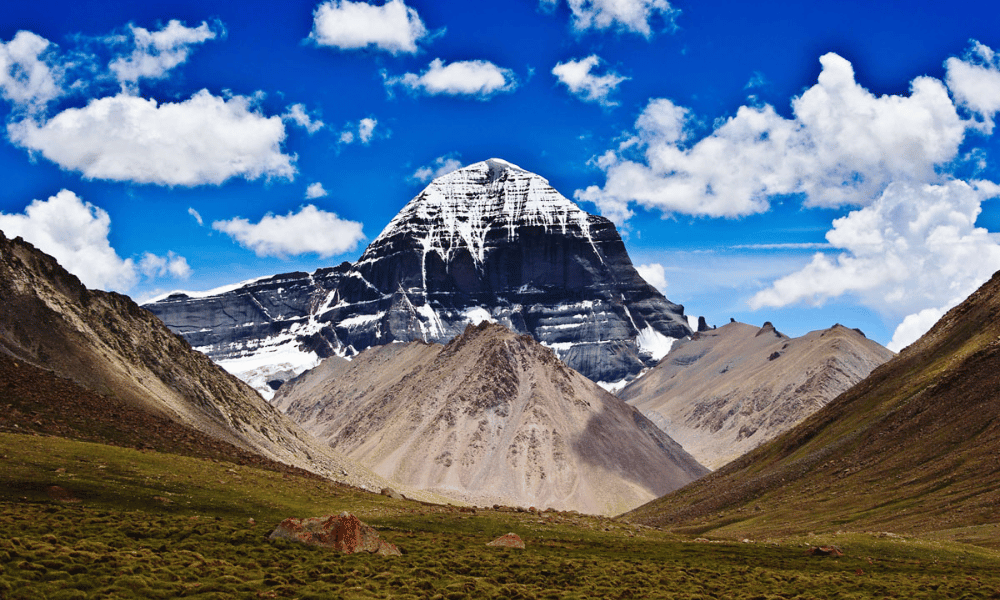Mount Kailash, located in the remote western part of Tibet, is one of the most revered and enigmatic mountains in the world, holding profound spiritual significance for multiple religions, including Hinduism, Buddhism, Jainism, and Bon. This majestic peak, rising to an elevation of 6,638 metres (21,778 feet), is often considered the axis mundi, or the centre of the universe, by these faiths. The mountain's symmetrical, pyramid-like structure and its snow-capped summit have inspired awe and reverence for centuries, with devotees believing that it has connections with Lord Shiva in Hinduism, Demchok in Buddhism, Rishabhadeva in Jainism, and the spiritual home of the Bonpo founder, Tonpa Shenrab Miwoche.
The allure of Mount Kailash extends beyond its physical beauty to its powerful spiritual presence. Pilgrims undertake the arduous journey to perform the Kailash Kora, a sacred 52-kilometre (32-mile) circumambulation of the mountain, which is believed to erase sins and bring about spiritual enlightenment. This pilgrimage, often done on foot or prostrating every few steps, is a profound act of devotion and faith. The path is challenging, traversing rugged terrain and high altitudes, yet it is imbued with a deep sense of peace and spiritual fulfilment. For Buddhists, the clockwise circumambulation represents the path to enlightenment, while for followers of Bon, the anticlockwise route honours their ancient traditions.
In addition to its spiritual allure, the area surrounding Mount Kailash is dotted with other attractions that hold religious and cultural significance. Lake Manasarovar, located near the base of the mountain, is one of the highest freshwater lakes in the world and is considered sacred. Pilgrims often bathe in its waters, believing it to purify their souls and bring good fortune. Nearby, Lake Rakshastal, with its stark, desolate beauty, contrasts with the tranquility of Manasarovar, offering a reflection on the dualities of existence. Monasteries such as the ancient Chiu Gompa provide a glimpse into the rich spiritual heritage and practices of the region. Together, these elements make Mount Kailash not just a geographical landmark but a profound pilgrimage site that continues to inspire and transform those who venture into its mystical realm.
Related Article: Kailash Parvat Photos
Mount Kailash Facts
Here are some facts about Mount Kailash that one might find useful:
|
Site |
Religious Mountain |
|
Location |
Ngari Prefecture, Tibet (Autonomous Region of China) |
|
Chinese Name |
Kangrinboqê or Gang Rinpoche |
|
Major Deities |
Lord Shiva (In Hinduism) Rishabhdeva (In Jainism) Buddha Cakrasamvara (In Buddhism) Tagzig Olmo Lung Ring (In Bon) |
|
Major River Origin |
Brahmaputra, Sutlej, Indus, Karnali, etc. |
|
Elevation |
6,638 metres (21,778 feet) |
|
Shape |
Pyramid |
|
Affiliation |
|
|
Nearby Attractions |
|
|
Mountain Climbing |
Restricted |
Where is Mount Kailash located?
Mount Kailash, a peak of great spiritual significance, is located in Nagri Prefecture (a remote southwestern area) in the Tibet Autonomous Region of China. This majestic peak lies near the sources of some of Asia’s mightiest rivers, making it a geographical and spiritual nexus. Revered by followers of multiple faiths, Mount Kailash is not only a place of reverence but also an amazing natural wonder.
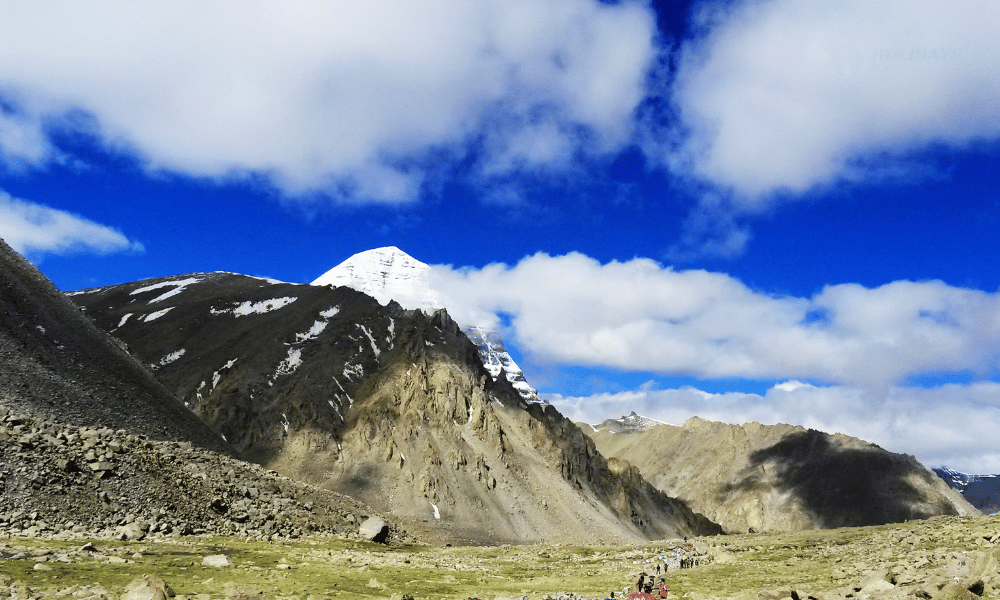
Geographical Overview
Mount Kailash is a part of the Kailash range within the border of the Trans Himalayan region. The mountain is surrounded by an array of geographical features, including vast plateaus, towering peaks, and sprawling river systems. It stands near the source of four major rivers: the Indus Sutlej, Brahmaputra, and Karnali, emphasising its crucial role in regional hydrology.
Altitude and Topography
Mount Kailash stands at an impressive altitude of 6,638 metres (21,778 feet). Unlike other high peaks in the region, it is notable for its distinct, symmetrical shape that resembles a pyramid. The mountain is part of the Kailash Range, which forms a part of the larger Trans Himalaya. Its unique topography includes sheer faces and deep valleys, making it both a challenging and awe-inspiring sight.
Climatic Condition
The climate around Mount Kailash is harsh and unpredictable, characterised by cold temperatures and strong winds. The region experiences long, severe winters, with temperatures often dropping well below freezing. Summers are short and cool, with temperatures occasionally reaching up to 15°C (59°F). That is why the best time to visit Mount Kailash is during the brief window from May to September, when the weather is relatively milder and more stable.
Weather Peculiarities
Mount Kailash is known for its unpredictable weather patterns. Even in the summer months, sudden snowstorms and rapid temperature drops are common. The mountain’s high altitude and remote location contribute to these extreme weather conditions, making it essential for visitors to be well prepared for sudden changes in weather. Due to the thin atmosphere at high altitudes, the sunlight can be intense with high levels of UV rays. So, visitors are advised to take precautions accordingly.
Wildlife and Vegetations
The Kailash region hosts a variety of wildlife adapted to its harsh climate and rugged terrain. Mammals such as snow leopards, blue sheep, Tibetan antelopes, and wild yaks exhibit remarkable resilience. Bird species like the Tibetan snowcock, bearded vulture, and Himalayan griffon vulture thrive in the high-altitude environment. Lake Manasarovar harbours fish species adapted to cold waters. Sparse vegetation, including hardy shrubs, grasses, and wildflowers, supports herbivores and the traditional medicinal practices of local communities.
Also Read: Kailash Mansarovar Yatra Difficulty
Significance of Mount Kailash
Mount Kailash holds a place of immense significance, revered both religiously and culturally by various communities around the world. Its unique status as a sacred peak transcends geographical and cultural boundaries, making it a symbol of spiritual and cultural unity.
Religious Significance
Mount Kailash holds immense religious significance for several major religions, including Hinduism, Buddhism, Jainism, and Bon. Here's a brief overview of its religious importance to each tradition:
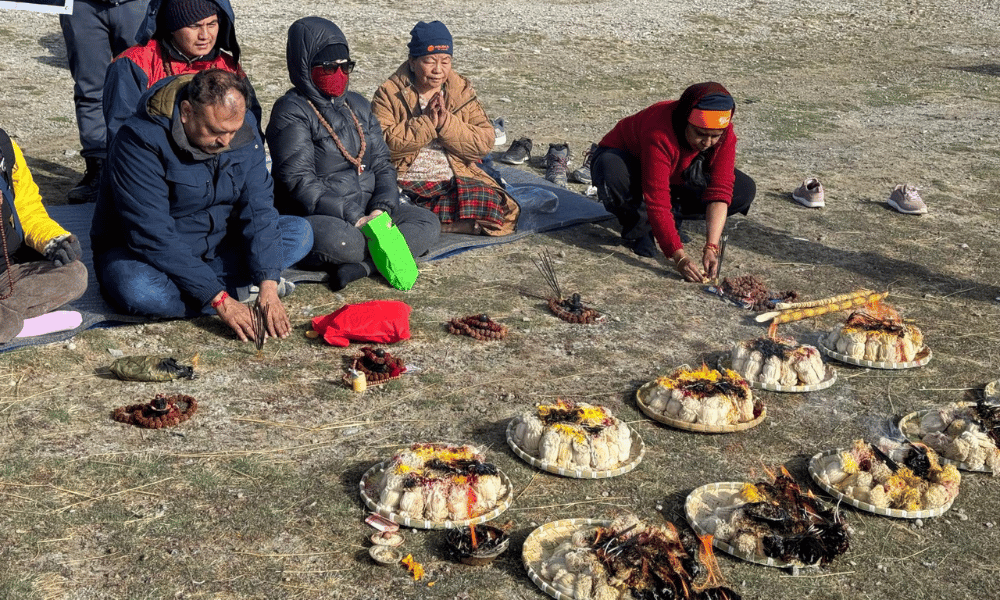
In Hinduism
Mount Kailash holds profound significance for Hindus, reverberating with layers of myth, spirituality, and pilgrimage. Known as the earthly abode of Lord Shiva, the Supreme God in Hinduism, Mount Kailash is regarded as the cosmic axis, the centre of the universe where heaven meets earth. It symbolises purity and spiritual transcendence, inviting seekers to embark on a journey of self-discovery and enlightenment. For Hindus, circumambulating Mount Kailash is a sacred rite believed to cleanse one's soul of sins and bring them closer to divine grace. The mythology surrounding Mount Kailash is rich and diverse, with stories depicting it as the dwelling place of Lord Shiva and his divine consort, Parvati. Its significance extends beyond religious realms, resonating deeply with cultural and philosophical ideals and embodying the eternal quest for spiritual enlightenment and the timeless dance of creation and destruction. Thus, Mount Kailash stands not only as a physical landmark but as a spiritual beacon, inspiring generations of Hindus to seek the divine within themselves.
In Buddhism
In Buddhist tradition, Mount Kailash is often ascribed as the dwelling place of deities such as Avalokiteshvara, the bodhisattva of compassion, who is revered as a central figure in Tibetan Buddhism. This sacred mountain serves as a beacon for practitioners seeking spiritual elevation and liberation from suffering, drawing pilgrims from far and wide to embark on the transformative journey of circumambulating its slopes. Alongside Avalokiteshvara, various local deities and protector spirits are believed to inhabit the mountain and its surrounding areas, embodying qualities of protection and benevolence. Pilgrims pay homage to these divine beings through rituals and offerings, seeking their blessings and guidance on the spiritual path. The presence of these revered figures infuses Mount Kailash with a profound sense of spiritual significance, inspiring devotees to cultivate compassion, wisdom, and inner peace as they tread the sacred path of enlightenment.
In Jainism
In Jainism, Mount Kailash is revered as Ashtapada, a place of immense spiritual significance deeply entrenched in Jain cosmology and mythology. According to Jain tradition, the mountain is believed to be the site where the first Jain Tirthankara, Rishabhadeva, attained enlightenment. Its towering presence symbolises the ascent to spiritual liberation and the conquest of worldly desires. Pilgrims undertake arduous journeys to Mount Kailash, seeking purification of the soul and liberation from the cycle of birth and death. The mountain serves as a reminder of the Jain principles of non-violence, truthfulness, and austerity, inspiring adherents to walk the path of righteousness and spiritual purity.
In Bonpo
In Bonpo, the indigenous religion of Tibet, Mount Kailash holds profound spiritual significance as the sacred seat of the deity Sipaimen, the lord of all existence. Revered as the axis mundi, or the centre of the universe, the mountain is believed to be the source of all creation and the focal point of spiritual energies. Bonpo practitioners undertake pilgrimages to Mount Kailash, performing rituals and offerings to appease deities and seek blessings for prosperity and spiritual advancement. The mountain's mystical aura and rugged terrain embody the essence of Bonpo spirituality, inspiring devotees to cultivate harmony with nature and transcend mundane existence through mystical practices and spiritual discipline.
Cultural Significance
Mount Kailash holds profound cultural and spiritual significance and is deeply revered by multiple religions and communities. Its status as a sacred mountain transcends national and cultural boundaries, making it a unique symbol of universal reverence.
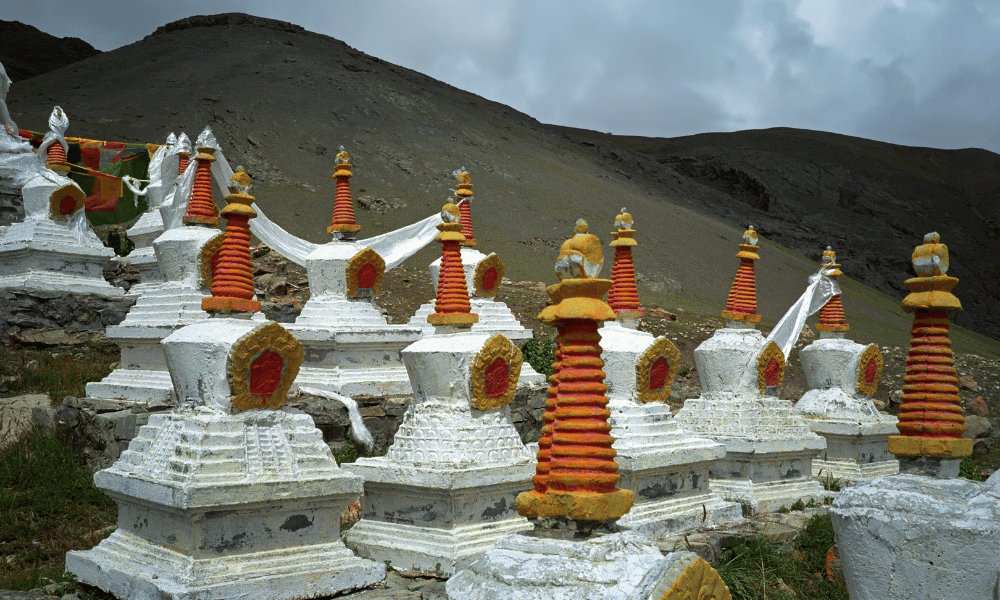
Local Culture and Traditions
The local culture around Mount Kailash is rich and deeply intertwined with the mountain's spiritual importance. Tibetan Buddhism, Hinduism, Jainism, and Bon all consider Kailash to be sacred. For Tibetan Buddhists, it is the abode of Demchok, a wrathful manifestation of Buddha; Hindus believe it is the residence of Lord Shiva and his consort Parvati. Jains regard it as the site where the first Tirthankara, Rishabhanatha, attained liberation, while followers of Bon see it as the sacred nine-story Swastika Mountain, the centre of their cosmology. Pilgrims undertake the arduous kora, a 52-kilometre circumambulation of the mountain, as an act of devotion, seeking spiritual merit and purification.
Major Festivals
The festivals around Mount Kailash are vibrant celebrations that highlight the spiritual, cultural, and natural aspects of the region. Here are some of the prominent festivals:
-
Saga Dawa Festival: This Buddhist festival marks the birth, enlightenment, and death of Buddha. It is a time for reflection, prayer, and acts of generosity, with many pilgrims performing the kora around Mount Kailash.
-
Tibetan New Year (Losar): Marking the Tibetan New Year, Losar includes elaborate ceremonies, prayers, traditional dances, and festive meals, symbolising renewal and community celebration.
-
Kailash Yatra: This pilgrimage festival attracts thousands of Hindu, Buddhist, Jain, and Bon devotees who journey to perform the sacred kora around Mount Kailash, fostering a sense of spiritual unity and devotion.
These festivals reflect the deep spiritual connection and rich cultural traditions of the region surrounding Mount Kailash. They offer a glimpse into the harmonious blend of spirituality and cultural heritage that defines this sacred area.
Nearby Attractions
Mount Kailash is surrounded by several attractions that enhance the pilgrimage experience and offer rich cultural, historical, and natural insights. Here are some notable attractions near Mount Kailash:
Lake Mansarovar
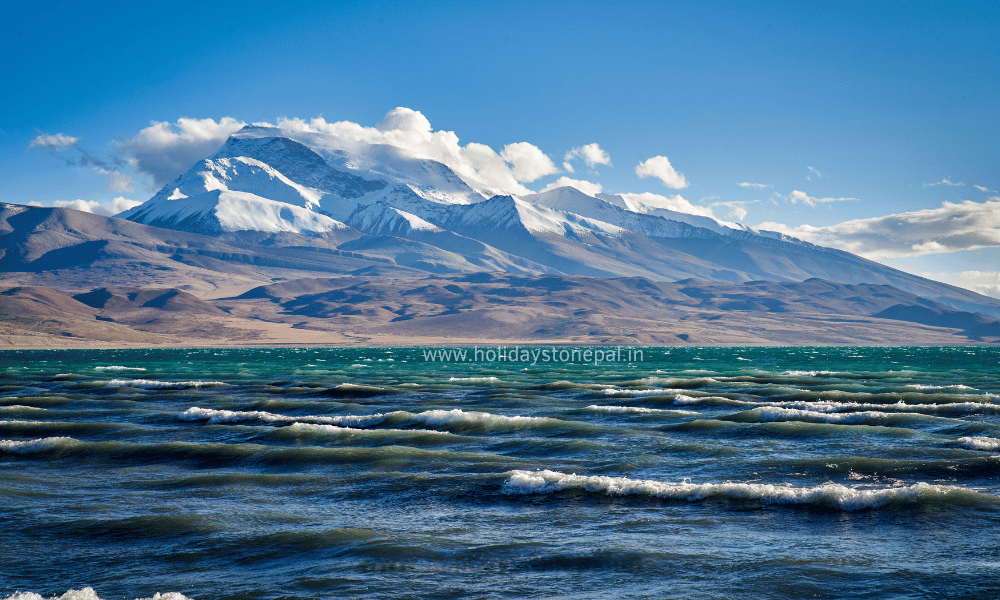
Situated in close proximity to Mount Kailash, Mansarovar Lake is a captivating nearby attraction that enhances the area's spiritual appeal. It is located at a remarkable altitude of 4590 metres and covers an area of around 320 square kilometres, making it one of the world's highest freshwater lakes. Mansarovar is deeply sacred to many religions, including Hinduism, Buddhism, Jainism, and Bon. According to Hindu religion, the lake was first created in the mind of Lord Brahma. Hence, in Sanskrit, it is called "Manasarovar", which is a combination of the words manas (mind) and sarovara (lake). Every year, pilgrims making the hard journey to Mount Kailash include a stop at Mansarovar, drawn by the opportunity to bathe in its sacred waters, which are believed to wash sins and grant spiritual enlightenment. Mansarovar Lake provides a calm and deeply tranquil environment that complements Mount Kailash's spiritual ambience and attracts both pilgrims and nature enthusiasts looking for peace and motivation amidst its spectacular natural beauty.
Learn More: Lake Mansarovar
Rakshas Taal
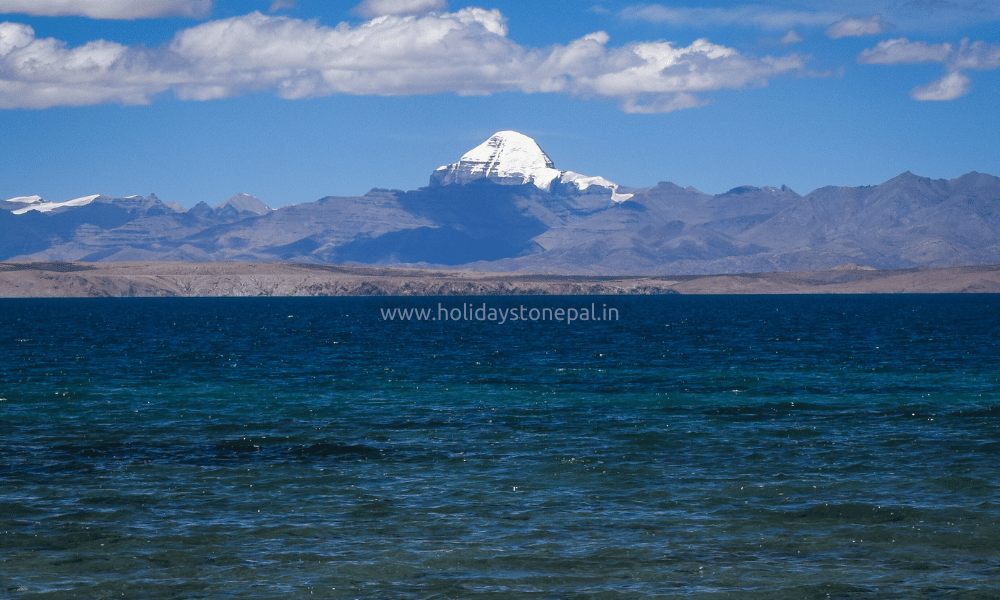
Rakshas Taal is a mysterious and breathtakingly beautiful lake that is also close to the holy Mount Kailash. According to Hindu mythology, Ravana, the demon king, built the lake to obtain Lord Shiva's blessings. This saline lake, located at a height of around 4,575 metres, has a lovely setting against the backdrop of the towering Himalayan mountains. With the English translation of its name being "Demon Lake," it carries a sense of mystery that is reminiscent of the local mythology and folklore. Despite its ominous name, the lake's calm waters and peaceful surroundings captivate pilgrims, adventurers, and nature lovers alike. The captivating blend of myth, spirituality, and natural splendour that characterises the sacred region encircling Mount Kailash is exemplified by Rakshas Taal, which is situated amidst the pristine wilderness and rugged landscape.
Yam Dwar

Located at an altitude of around 5,400 metres, Yam Dwar, also known as the “Gate of the Dead”, holds significant cultural and spiritual significance as a pivotal point along the sacred pilgrimage route circumambulating Mount Kailash in Tibet. People from Tibet call it Traboche and host festivals like the Saga Dawa here. Pilgrims believe that passing through Yam Dwar represents letting go of worldly attachments and going on a spiritual journey. Though the name is intimidating, the path provides breath-taking vistas of the neighbouring Himalayan peaks and acts as a spiritual entryway for those looking for peace, reflection, and heavenly favour among the stunning scenery.
Gauri Kund
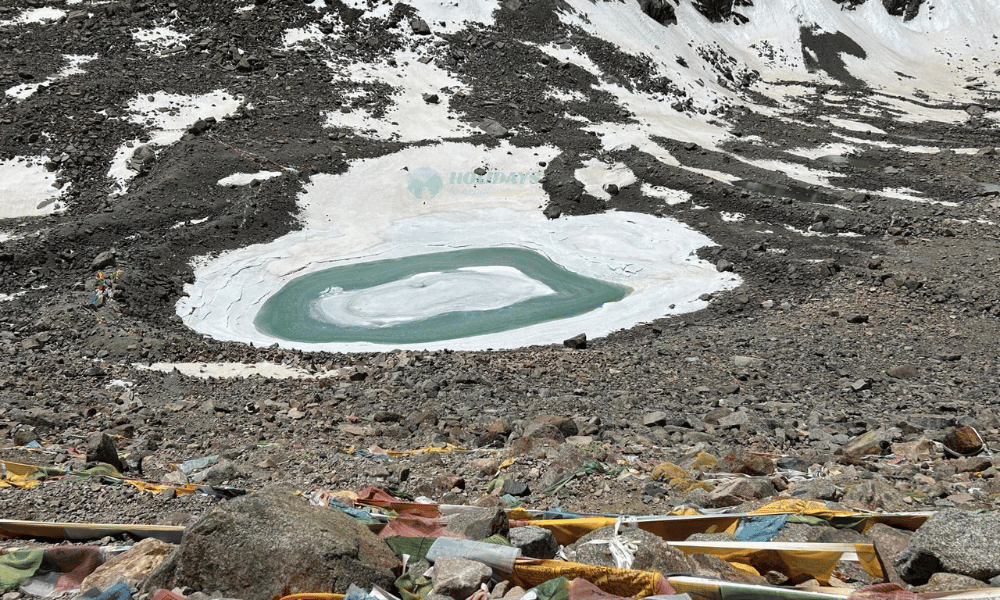
Gauri Kund, located in the stunning Himalayan scenery near Mount Kailash, has profound spiritual significance as a sacred water body in Hindu mythology. This magnificent lake, located at an altitude of around 5,600 metres, is believed to be where Goddess Parvati (Lord Shiva's consort), also known as Gauri, bathed. According to Hindu mythology, Gauri Kund is also where Goddess Parvati undertook painful devotion to win Lord Shiva's heart, eventually leading to their divine union. Pilgrims travelling around Mount Kailash frequently make a quick halt at Gauri Kund to cleanse themselves in its holy waters, seeking blessings for marital peace, fertility, and spiritual purity.
Nandi Parvat

Nandi Parvat, the gatekeeper of the sacred route leading to Mount Kailash, has a remarkable similarity to Lord Shiva’s celestial vehicle, Nandi. This towering mountain commands attention with its awe-inspiring presence as a silent witness to the spiritual voyage of the Kailash Mansarovar Yatra. Nandi Parvat serves as a symbol of calm majesty, encouraging pilgrims along the journey of inner kora. Its imposing stature serves as a source of both reflection and inspiration, adding a depth of reverence to the spiritual journey of Kailsh Mansarivar. Pilgrims are intrigued by a prominent landmark in the calm magnificence of Nandi Parvat, which adds a profound dimension to their sacred journey.
Ashtapad
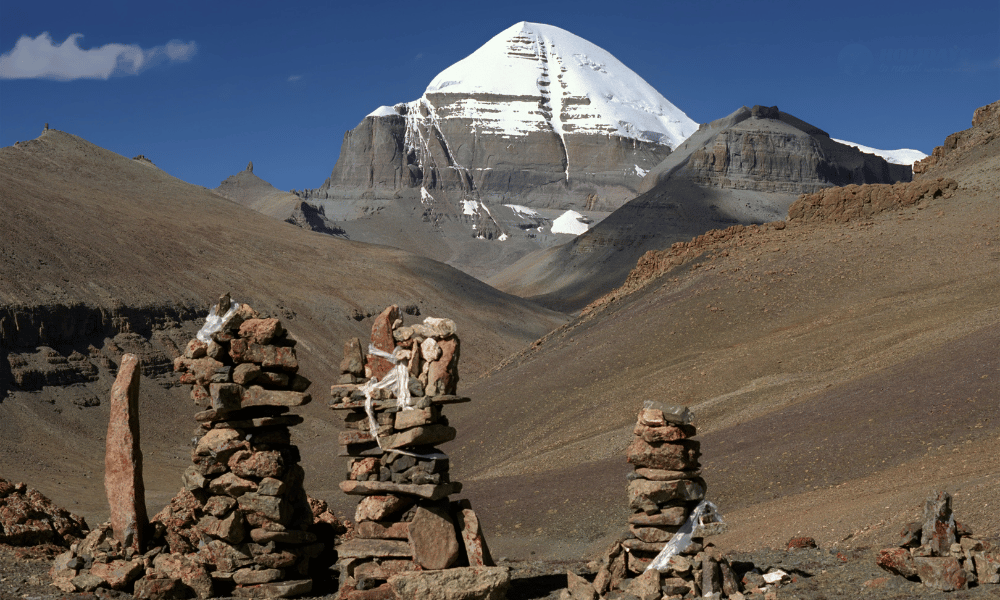
Ashtapad, located near Mount Kailash, is a revered pilgrimage site steeped in spiritual significance across multiple faiths. Located at an altitude of approximately 4,625 metres, Ashtapad is believed to be the legendary abode of Lord Shiva and Goddess Parvati. According to Hindu mythology, it is atop this sacred peak that Lord Shiva is said to have revealed the secrets of the universe to his consort, Parvati. In Jainism, Ashtapad holds immense importance as the place where the first Tirthankara, Rishabhanatha, attained enlightenment. Pilgrims and seekers of truth flock to Ashtapad, undertaking the arduous journey to its summit in search of spiritual enlightenment and divine blessings. Surrounded by the awe-inspiring beauty of the Himalayas, Ashtapad offers a serene and transcendent ambiance, inviting devotees to connect with the divine essence believed to permeate its sacred grounds. Ashtapad stands as a timeless symbol of spiritual aspiration and divine revelation, beckoning pilgrims from far and wide to experience the profound sense of peace and transcendence that pervades this hallowed mountain peak.
Related Read: What is Kailash Mansarovar Yatra?
Kailash Pilgrimage
The Kailash Pilgrimage, also known as the Kailash Mansarovar Yatra, is one of the most revered holy journeys in the world. This sacred pilgrimage involves travelling to Mount Kailash and Lake Mansarovar, located in the Tibet Autonomous Region of China. Pilgrims from various faiths, including Hinduism, Buddhism, Jainism, and Bon, undertake this arduous journey to perform a parikrama (circumambulation) around Mount Kailash, seeking spiritual growth, blessings, and enlightenment. The pilgrimage is divided into two main routes: the Outer Kora and the Inner Kora.
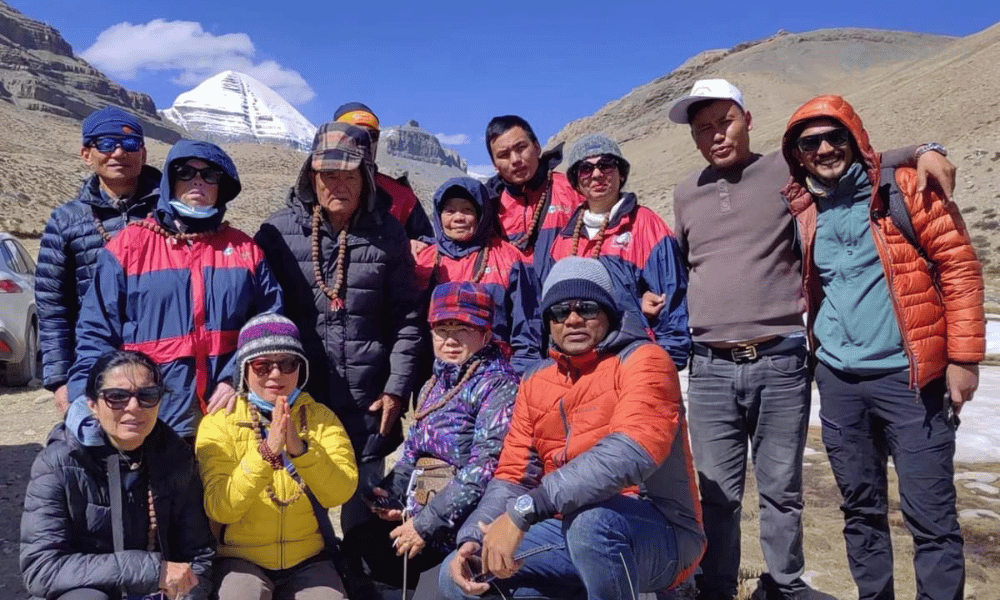
The Outer Kora
The Outer Kora is the most popular and well-trodden path around Mount Kailash. It is considered highly auspicious to complete this 52-kilometre trek, believed to cleanse one's sins and bring spiritual merit. For Buddhists, completing 108 rounds of the Outer Kora is a way to attain enlightenment, while Hindus believe that circumambulating Mount Kailash eradicates the sins of a lifetime.
Route Attractions
-
Yam Dwar: The gateway to the Outer Kora, marking the start of the pilgrimage.
-
Dirapuk Monastery: Located at the north face of Mount Kailash, offering stunning views and a place for rest.
-
Dolma La Pass: The highest point of the trek at 5,630 metres, symbolising a spiritual ascent.
-
Gauri Kund: A sacred lake associated with the Hindu goddess Parvati, visited by pilgrims for its holy waters.
Physical Demand
The Outer Kora is physically demanding, requiring good acclimatisation due to high altitudes ranging from 4,675 metres to 5,630 metres. Pilgrims must be prepared for challenging terrain, unpredictable weather, and thin air, which can lead to altitude sickness.
Route Details
The journey typically starts in the small town of Darchen. The trek is divided into three stages:
Darchen to Dirapuk: A gradual ascent with stunning views of the west face of Kailash.
Dirapuk to Zuthulphuk: Crossing the Dolma La Pass and descending to the valley.
Zuthulphuk to Darchen: A relatively easier walk back to the starting point, completing the kora.
The Inner Kora
The Inner Kora is considered even more sacred and challenging than the Outer Kora. It brings pilgrims closer to the mountain and its spiritual energy. This route is less frequented due to its difficult terrain and the need for a special permit. Completing the Inner Kora is believed to confer profound spiritual benefits and deeper cleansing of past karmas.
Route Attractions
-
Charan Sparsh: A significant point where pilgrims can touch the feet of Mount Kailash.
-
Kuber Kund: A sacred lake associated with wealth and prosperity.
-
AtmaLingam: A significant spiritual site believed to hold immense spiritual power.
-
Nandi Parvat: A mountain named after Lord Shiva's bull, considered highly sacred.
-
Saptarishi Caves: Caves associated with the seven great sages, offering a deeply spiritual experience.
-
Serlung Gompa: A monastery that provides panoramic views and a closer connection to the spiritual essence of Mount Kailash.
Physical Demand
The Inner Kora is more physically demanding than the Outer Kora due to its higher altitude, steeper paths, and more rugged terrain. It requires excellent physical fitness, experience with high-altitude trekking, and thorough acclimatisation.
Route Details
The Inner Kora involves three important legs:
-
Charan Sparsh from Dirapuk (6 km trek): The journey starts from Dirapuk (4,890 metres) and involves a 6 km trek to Charan Sparsh, a point where pilgrims can touch the feet of Mount Kailash. Touching the feet of the mountain is believed to impart immense spiritual blessings and a direct connection to the divine.
-
Kuber Kund Trek from Shiva Tsal to Zuthulphuk (18 km trek): This segment starts from Shiva Tsal (5,320 metres) and involves an 18 km trek to Zuthulphuk (4,820 metres), passing by the sacred Kuber Kund. Kuber Kund is associated with the god of wealth and is a significant site for seeking blessings for prosperity and spiritual wealth.
-
Nandi Kora: Starting from Darchen (4,575 metres), this route includes several spiritually significant sites:
- Nandi Parvat Kora: A circumambulation of Nandi Parvat (6,000 metres), symbolising a deep connection to Lord Shiva.
- Ashtapad Trekking: Trekking to Ashtapad (5,110 metres), a site important in Jainism.
- AtmaLingam: A spiritually potent site believed to hold great power.
- Saptarishi Caves: Caves associated with the seven great sages (5,820 metres), offering a profound spiritual experience.
Nandi Kora is considered the heart of the Inner Kora, encompassing major spiritual landmarks that are crucial for a complete spiritual journey.
The Inner Kora is a demanding pilgrimage, requiring physical endurance, spiritual dedication, and careful preparation. Completing these three legs of the Inner Kora is seen as a significant spiritual achievement, offering deep spiritual rewards and a closer connection to the divine essence of Mount Kailash.
Learn More: Kailash Inner Kora
Our Tour Packages
Holidays to Nepal has been providing Kailash Pilgrims with expertly prepared tour packages for years. We provide everything from luxurious helicopter flights to individual tours and group joining packages to Kailash. Here are some of the famous Kailash Yatra tour packages we offer:
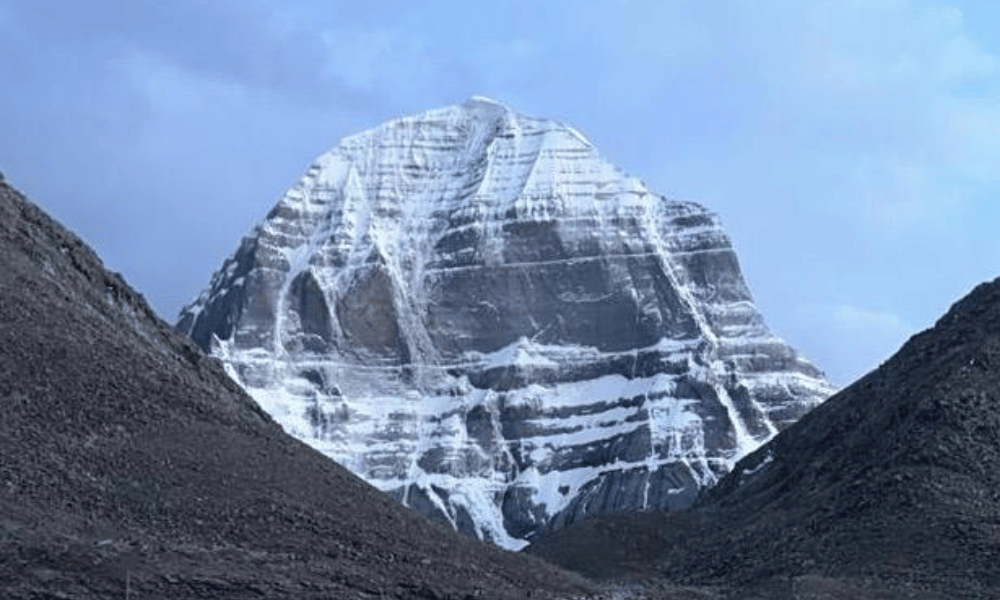
Kailash Mansarovar Yatra by Helicopter
Kailash Mansarovar Yatra by Helicopter is a spiritual journey that fulfils your desire to visit Mt. Kailash and the sacred lake Mansarovar. This is a simpler and quicker approach to completing the tour. It is recommended for seniors and physically weak people to make travelling easier for them. The helicopter journey begins in Nepalgunj and continues to Hilsa by helicopter, followed by a drive to Manasarovar.
Here is an outline itinerary of Kailash Mansarovar Yatra by Helicopter:
|
DAY 01: Kathmandu Arrival. (1400 m) |
|
DAY 02: Kathmandu Sightseeing. |
|
DAY 03: Bhaktapur Sightseeing. |
|
DAY 04: Chandragiri Sightseeing. |
|
DAY 05: Pack and Fly to Nepalgunj. |
|
DAY 06: Fly from Nepalgunj to Simikot. (2910 m) |
|
DAY 07: Simikot - Hilsa - Taklakot. (4025 m) |
|
DAY 08: At Taklakot – Rest Day Full Day – Free for Acclimatisation. |
|
DAY 09: Drive from Taklakot to Lake Mansarovar. (4650 m) |
|
DAY 10: Drive to Yama Dwara, Trek to Deruphuk. (4050 m) |
|
DAY 11: Trek to Zuthulphuk. (4800m) |
|
DAY 12: Zutulphuk to Hilsa or Simikot. |
|
DAY 13: Hilsa to Simikot, Fly back to Kathmandu via Nepalgunj. |
|
DAY 14: Transfer to Airport. |
Learn More: Kailash Mansarovar Yatra by Helicopter
Kailash Mansarovar Yatra by Drive Via Kyirong
The Kailash Mansarovar Yatra, departing from Nepal through Kyirong, offers a transformative journey blending pilgrimage and adventure amidst the majestic landscapes of the Tibetan plateau. Mount Kailash and Mansarovar Lake are spiritual icons that travellers witness while immersed in the Himalayan beauty. The yatra begins in Nepal's diverse regions and continues through picturesque valleys to the Kyirong border, where visitors are greeted by Tibetan culture in peaceful surroundings. Following ancient paths, the pilgrimage to Kailash and Mansarovar becomes a spiritual sojourn, fostering introspection and connection with the divine amidst the awe-inspiring natural scenery, inviting individuals to embark on a journey of self-discovery and enlightenment.
Here is an outline itinerary of Kailash Mansarovar Yatra by Drive Via Kyirong:
|
DAY 01: Kathmandu Arrival. |
|
DAY 02: Kathmandu Sightseeing, Visa Application. |
|
DAY 03: Bhaktapur Sightseeing. |
|
DAY 04: Chandragiri Sightseeing. |
|
DAY 05: Packing and Final Preparation. |
|
DAY 06: Drive from Kathmandu to Dhunche or Syabrubesi or Timure. |
|
DAY 07: Drive to Kyirong. (2850 m) |
|
DAY 08: Drive to Saga. (4500 m) |
|
DAY 09: Drive from Saga to Lake Mansarovar. (4650 m) |
|
DAY 10: Drive to Darchen. (4700 m) |
|
DAY 11: Drive to Yama Dwara Trek to Deruphuk. (4050 m) |
|
DAY 12: Trek to Zuthulphuk. (4800 m) |
|
DAY 13: Zuthulphuk to Saga. (4500 m) |
|
DAY 14: Drive back to Kyirong. (2850 m) |
|
DAY 15: Drive to Kathmandu. (1400 m) |
|
DAY 16: Transfer to Airport. |
Learn More: Kailash Mansarovar Yatra by Drive via Kyirong border
Kailash Mansarovar Yatra Private Tour
The Kailash Mansarovar Yatra Private Tour is tailored for those seeking a personal journey amidst the sacred beauty of Kailash Mansarovar. Over 16 days, pilgrims will explore Kathmandu, traverse the Nepal-Tibet border, and trek through Tibet's Himalayas at their own pace. The spiritual energy of this revered site can be experienced while enjoying the comfort and serenity of a private drive, designed to enhance your quest for inner peace and connection with the divine.
Here is an outline itinerary of Kailash Mansarovar Yatra Private Tour:
|
DAY 01: Kathmandu Arrival. |
|
DAY 02: Kathmandu Sightseeing, Visa Application. |
|
DAY 03: Bhaktapur Sightseeing, Nagarkot Stay. |
|
DAY 04: Chandragiri Sightseeing. |
|
DAY 05: Packing and Final Preparation. |
|
DAY 06: Drive to Dhunche or Syabrubesi or Timure. |
|
DAY 07: Drive to Kyirong. (2850 m) |
|
DAY 08: Drive to Saga. (4500 m) |
|
DAY 09: Drive from Saga to Lake Mansarovar. (4650 m) |
|
DAY 10: Drive to Darchen. (4700 m) |
|
DAY 11: Drive to Yama Dwara, Trek to Deruphuk. (5050 m) |
|
DAY 12: Trek to Zuthulphuk. (4800 m) |
|
DAY 13: Zuthulphuk to Saga. (4500 m) |
|
DAY 14: Drive back to Kyirong. (2850 m) |
|
DAY 15: Drive to Kathmandu. (1400 m) |
|
DAY 16: Transfer to Airport. |
Learn More: Kailash Mansarovar Yatra Private Tour
Travelling to Mount Kailash
Travelling to Mount Kailash requires a well thought out plan. Since it falls at a high altitude, lots of caution should be taken while doing the yatra. A journey to Mount Kailash is not just an ordinary travel experience; it is a spiritual odyssey that holds profound significance for many across the globe. Nestled in the remote regions of Tibet, this sacred mountain appeals to pilgrims and adventurers alike, offering a unique blend of physical challenge and spiritual enlightenment. However, the journey to this revered site requires meticulous planning and preparation.
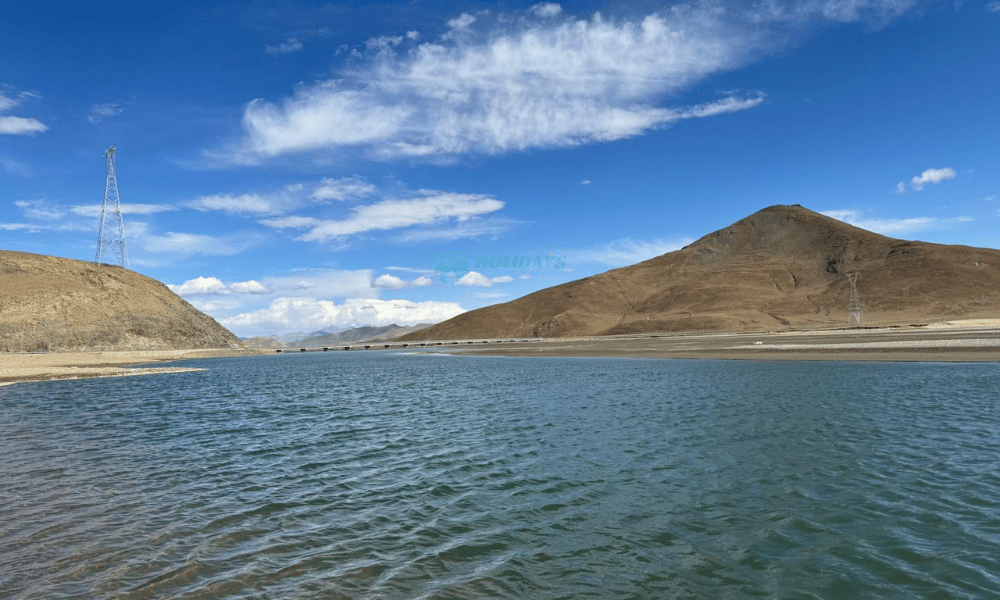
Necessary Documents
Travelling to Mount Kailash involves crossing international borders and often entering restricted areas, so several important documents are required:
-
Passport: A valid passport with at least six months of validity from the date of entry is essential.
-
Chinese Visa: As Mount Kailash is in Tibet, travellers need a Chinese visa, which should be obtained from the Chinese embassy or consulate in their home country.
-
Travel Insurance: Considering the remote location and the rigours nature of the trek, securing a comprehensive travel insurance policy is advisable.
-
Tibet Travel Permit: Issued by the Tibet Tourism Bureau, this permit is mandatory for entry into Tibet. It is typically arranged through a travel agency.
Health and Fitness Essentials
Travelling to Mount Kailash involves high-altitude trekking and can be physically demanding. Proper health and fitness preparation is crucial to ensuring a safe and enjoyable journey.
-
Medical Checkup: Before embarking on the trip, it is advisable to undergo a comprehensive medical check-up to ensure there are no underlying health conditions that could be exacerbated by high-altitude travel.
-
Fitness Training: Engage in a fitness regimen that includes cardiovascular exercises, strength training, and endurance-building activities to prepare for the physical demands of the trek.
-
Acclimatisation: Gradual acclimatisation to high altitudes is essential to preventing altitude sickness. Plan the itinerary to include rest days and gradual elevation gain.
-
Hydration: Maintaining proper hydration is crucial at high altitudes. Drink plenty of fluids and avoid alcohol and caffeine.
-
Medication: Consult with a healthcare provider about medications for altitude sickness, such as acetazolamide (Diamox), and carry a well-stocked first aid kit.
Learn More: 10 Must Know Things Before Visiting Kailash
Mount Kailash on Map
Here is the exact location of Mount Kailash on Google Maps.
Best Time to Visit Kailash
The best time to visit Mount Kailash largely depends on your priorities and preferences. However, there are certain seasons and months that are generally considered more suitable for pilgrimages and treks to this sacred mountain.

-
Spring (April to June): Mild temperatures, clear skies, ideal for trekking, blooming wildflowers enhancing the landscape.
-
Autumn (September to October): Crisp air, stable weather, clear skies providing excellent visibility, and vibrant autumn foliage adding to the beauty.
-
Monsoon Season (July to August): Lush green landscape, different perspective of natural beauty, but be prepared for muddy and slippery trails, as well as the possibility of landslides.
-
Winter (November to March): Not recommended due to harsh weather conditions, freezing temperatures, heavy snowfall, and impassable or extremely difficult trekking routes.
Learn More: Best time to Visit Mount Kailash
Travel Tips
When travelling to Mount Kailash, it is critical to plan ahead and prepare sufficiently. Ensuring the right and necessary stuff to carry on the journey can greatly improve the entire experience. To avoid altitude sickness, keep the high altitude in mind and acclimatise correctly. Respect local customs and traditions, and use Leave No Trace principles to reduce your environmental impact.

Things to Carry
To guarantee comfort, safety, and preparedness for the road ahead, packing essentials for a trip to Mount Kailash demands considerable thought.
Essential Items:
-
Sturdy hiking boots: Provide traction and ankle support on rugged terrain.
-
Warm clothing layers: Protect against fluctuating temperatures and inclement weather.
-
Sleeping bag: Provides warmth during overnight stays.
-
Sunscreen: Shields against sunburn and UV radiation.
-
Headlamp/flashlight: Offers visibility in low-light conditions.
-
Multi-tool/knife: Useful for various tasks and emergencies.
Additional Items:
-
Refillable water bottle: Stay hydrated throughout the journey.
-
High-energy snacks: Provide sustenance during long treks.
-
Sunglasses and hats: Protect against glare and sun exposure.
-
First aid kit: Essential for treating minor injuries.
-
Portable phone charger: Ensure devices stay powered for communication and navigation.
Learn More: Kailash Mansarovar Yatra Packing List Suggestion
Sustainable Tourism
Respecting the natural environment and cultural heritage of Mount Kailash is paramount. Consider the following points for sustainable tourism:
-
Stay on designated trails: Minimise ecosystem disruption by sticking to established paths and avoiding trampling on sensitive vegetation.
-
Pack out all waste and litter: Preserve the pristine beauty of the area by carrying out all trash and waste, leaving no trace of your visit behind.
-
Support local businesses: Contribute positively to the local economy and community by patronising locally owned shops, restaurants, and accommodations that prioritise environmental conservation and sustainable practices.
-
Learn and respect local customs: Familiarise yourself with the customs and traditions of the region, and ensure your actions and interactions with locals are respectful and culturally sensitive.
-
Reduce environmental footprints: Minimise water usage, energy consumption, and waste generation during your visit, and opt for eco-friendly transportation options whenever possible.
Also Read: Kailash Yatra Information For NRIS
Conclusion
Mount Kailash is a symbol of both natural majesty and spiritual significance. Many people throughout history have been captivated by its remarkable pyramid shape and remote location in the Tibetan Himalayas. Honoured in Buddhism, Jainism, Hinduism, and Bon, this hallowed peak is believed to be a powerful spiritual hub and the dwelling place of divine beings. Pilgrims from all over the world make the difficult journey around Mount Kailash, seeking blessings, cleansing, and a closer connection to the divine.
The allure of Mount Kailash is not only derived from its religious significance but also from its unspoilt natural beauty. Surrounded by rugged terrain, pristine lakes, and breathtaking scenery, the mountain provides an unforgettable experience for both adventurers and spiritual seekers. The Kora, or journey around the mountain, is a test of physical endurance and spiritual dedication, attracting those seeking personal transformation and a closer connection to nature's wonders.
Finally, Mount Kailash is an eternal symbol of humanity's search for purpose, enlightenment, and connection to something greater than ourselves. Mount Kailash offers a profound and lasting experience, whether one is drawn by faith, adventure, or simply the awe of its presence. We are reminded of the eternal power of hallowed places and the profound spiritual traditions that never cease to inspire and guide us on our life's journey as we consider their significance. As you prepare for this incredible journey, the travel tips and information offered will ensure that your visit to this sacred mountain is meaningful and memorable. Take advantage of this unique opportunity to visit Mount Kailash, and let its calm yet powerful energy leave a lasting impression on your spirit.
Listen Our Podcast: Mount Kailash
Frequently Asked Questions (FAQ’s)
Here are some of the most frequently asked questions about Mount Kailash:
How tall is Mount Kailash?
Mount Kailash stands at an elevation of 6,638 metres (21,778 feet) above sea level.
Who lives on Mount Kailash?
Mount Kailash is considered to be the abode of Lord Shiva, one of Hinduism's three primordial gods, along with his consort Pravati and two sons, Ganesha and Kartikeya.
Why has no one climbed Mount Kailash?
Mount Kailash is considered unclimbable primarily due to its sacred status in several religions, including Hinduism, Buddhism, Jainism, and the Bon religion. Additionally, the harsh climatic conditions and the mountain's remote location add to its inaccessibility.
Learn More: Why is Mount Kailash Unclimbable?
What is so special about Mount Kailash?
Mount Kailash is sacred in Hinduism, Buddhism, Jainism, and Bon. It is believed to be the abode of Lord Shiva in Hinduism and a spiritual centre for enlightenment in other religions. Its unique pyramid shape and remote location in Tibet draw many pilgrims on spiritual journeys.
Where is Mount Kailash located?
Mount Kailash is located in the Ngari Prefecture of Tibet, an autonomous region of China.
Can we touch Mount Kailash?
Yes, if one is doing an inner kora, they can get to the Charan Sparsh point and touch Mount Kailash's base.
How much does a Kailash trip cost?
Many factors influence the cost of a Kailash journey, including whether it is private or group, nationality, route, comfort, and so on. However, the trip normally starts at around $3000 USD.
Learn More: How Much Does a Kailash Yatra Cost?
What is the age limit for travelling to Kailash?
There's no official age limit for visiting Mount Kailash, but trekking or doing the pilgrimage around it can be physically demanding. So, as long as one is active and fit enough to manage the harsh terrain and can endure the trek, they can travel to Kailash.
What is the best time to visit Mount Kailash?
The best time to visit Mount Kailash would be in the summer (June to August). The summer months are considered the best time to visit Kailash Mansarovar. Temperatures can reach up to 15 °C in the daytime but can still drop to 0 °C or less during the night.
What is Mount Kailash Kora?
The Mount Kailash Kora is a sacred pilgrimage route around Mount Kailash in Tibet, China. There are two routes the Inner Kora route and the Outer Kora route. People of various faiths undertake it, seeking spiritual blessings.
What is Mount Kailash Shiva Face?
People believe that if they observe the west face of Mount Kailash carefully, they will see a massive human-like face on its surface, which is considered to be of Lord Shiva.

